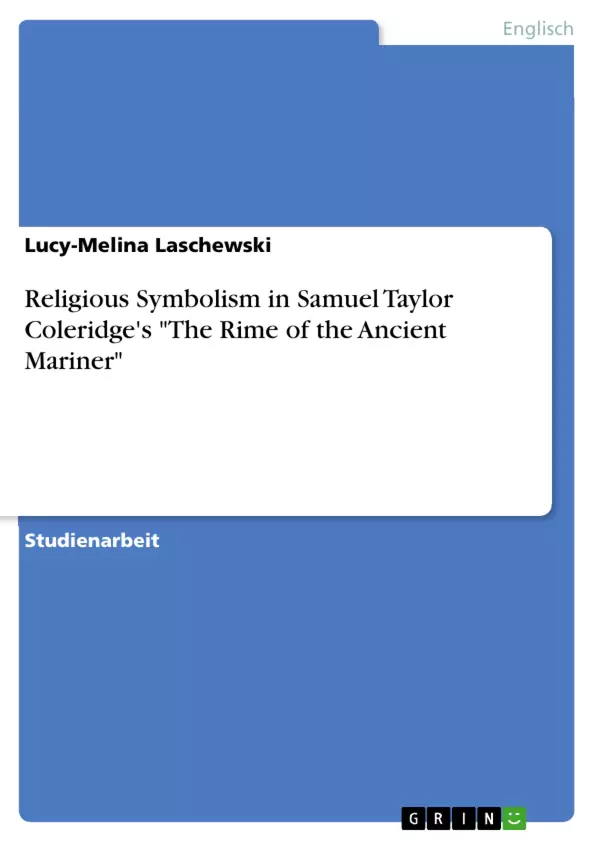This paper aims to show that the Christian symbolism in the poem works as a reflection of Coleridge's attempt at reconciling his religious faith with his secondary philosophical beliefs and will analyse form and imagery in regard to if he succeeds at doing so through theological symbolism.
An initial point of concern will be Coleridge’s relationship to religion and a general overview on his thoughts concerning religion and reason will be provided to get a further understanding of his viewpoint. J. Robert Barth's study of Coleridge and Christian Doctrine will provide an analytical basis for this matter. In light of Coleridge's history with religion and philosophy, "The Rime of the Ancient Mariner" is going to be examined in regard to its theological symbolism.
As Coleridge revised the poem quite a few times in language and imagery, I decided to base my analysis solely on the 1718 version of the poem as this gives view to a more refined and thus adapted choice of words, which might find themselves more in coherence with Coleridge’s thinking. Moreover, does this choice also simplify the matter at hand regarding the limited scope of this work.
However, the incident of the poem's revisions themselves will find its place in the conclusion of this paper. Focusing on the symbols used in the poem, only a selection of lines and motifs will be analysed, including imagery revolving around the sea voyage (water, ship), the Albatross and Watersnakes, as well as a brief look on the image of the wedding, which is chosen as frame narrative for this ballad. These have been partly chosen in prospect to their significance on attempting to create a sense of unity.
Inhaltsverzeichnis
- Introduction
- Coleridge and Religion
- Religious Faith and Natural Reason
- The Symbol
- Religious Symbolism in the Rime of the Ancient Mariner
- Sea Voyage: The Importance of the Water and the Ship
- Sacred Meaning of Animals: The Albatross and the Watersnakes
- Conclusion
Zielsetzung und Themenschwerpunkte
Diese Arbeit zielt darauf ab, die christliche Symbolik in Samuel Taylor Coleridges Gedicht "The Rime of the Ancient Mariner" als Reflexion von Coleridges Versuch darzustellen, seinen religiösen Glauben mit seinen sekundären philosophischen Überzeugungen in Einklang zu bringen. Die Arbeit analysiert Form und Bildsprache in Bezug auf die Frage, ob Coleridge durch theologische Symbolik in diesem Bemühen erfolgreich ist.
- Coleridges Verhältnis zu Religion und seine Gedanken über Religion und Vernunft
- Die Verwendung christlicher Symbolik in "The Rime of the Ancient Mariner"
- Die Bedeutung von Meeresfahrt, Tierbildern (Albatros, Wasserschlangen) und der Hochzeitsbilder in Bezug auf den Versuch, ein Gefühl der Einheit zu schaffen
- Der Einfluss von Coleridges Unitarianismus auf seine Ansichten über soziale Verantwortung und die Verbindung von religiösem Glauben und politischem Handeln
- Coleridges Versuch, Glauben mit natürlicher Vernunft in Einklang zu bringen
Zusammenfassung der Kapitel
Das erste Kapitel bietet einen einleitenden Überblick über "The Rime of the Ancient Mariner" und seine Bedeutung in der romantischen Literatur. Es stellt die Problematik der theologischen Interpretation des Gedichts im Kontext der modernen Literaturkritik dar und betont die Relevanz von Coleridges eigener religiöser Entwicklung für die Analyse des Gedichts.
Das zweite Kapitel beleuchtet Coleridges Beziehung zu Religion und seine Ansichten über Religion und Vernunft. Es analysiert seine Unitarianismus-Phase und seine spätere Rückkehr zum Trinitarischen Christentum, wobei die Einflüsse von David Hartley und Immanuel Kant auf seine philosophischen Überzeugungen hervorgehoben werden.
Das dritte Kapitel untersucht die christliche Symbolik in "The Rime of the Ancient Mariner" und konzentriert sich auf die Bilder der Meeresreise, des Albatrosses, der Wasserschlangen und der Hochzeitsbilder. Es analysiert, wie diese Symbole Coleridges Bemühungen widerspiegeln, seinen Glauben mit seiner Philosophie in Einklang zu bringen.
Schlüsselwörter
Die wichtigsten Schlüsselwörter und Themen des Textes sind: Samuel Taylor Coleridge, "The Rime of the Ancient Mariner", Religiöse Symbolik, Christentum, Unitarianismus, Trinitarisches Christentum, Vernunft und Glauben, David Hartley, Immanuel Kant, Meeresfahrt, Albatros, Wasserschlangen, Hochzeit, Einheit.
- Citation du texte
- Lucy-Melina Laschewski (Auteur), 2019, Religious Symbolism in Samuel Taylor Coleridge's "The Rime of the Ancient Mariner", Munich, GRIN Verlag, https://www.grin.com/document/888969



